
The bigger your influencer campaigns get, the more your approach to content tracking matters.
Especially when it’s easy to lose track of all the moving pieces of managing influencers.
From juggling creator agreements to checking your campaign performance, there's a lot of ground to cover. You can’t wing it if you're doing 100s of creator collabs every month.
But if it makes you feel any better, even "big" brands struggle with influencer tracking.
In this post, we’ll break down our best tips and recommended influencer tracking tools to make your creator campaign more productive and less chaotic.
What is Influencer Content Tracking?
Influencer content tracking refers to gathering and measuring the performance of your brand's influencer posts. This includes monitoring details such as engagement rate, how many posts are live and whether you have the content rights to promote your posts.
The concept of content tracking might seem pretty obvious. That said, brands either overlook how they measure influencer content or simply don't track important details like usage rights.
Below is a breakdown of what brands need to keep an eye on.
Tracking Influencer Posts
No surprises here! Photos, videos, Stories and other types of UGC produced by creators are your first things to track. This is where your content measurement quite literally starts.
For example, let's say your brand is actively running an influencer campaign or is passively collecting UGC. You should be tracking:
- How many posts have been made as a result of your campaign
- Whether you have the actual downloadable files for your influencer content versus URLs
- Which posts (if any) are being promoted as influencer ads
Tracking Campaign Performance & Engagement
Monitoring metrics and KPIs is critical.
Not just for the success and sake of your influencer marketing strategy, but also getting buy-in to highlight that your campaigns are producing results. With data-backed influencer tracking, you can prove influencer marketing ROI to key stakeholders with confidence.
Here's a snapshot of what you should be able to define for your influencer marketing campaigns without digging:
- Engagement rate and interactions
- Reach
- Plays and loops
- Pieces of content earned
Tracking influencer performance starts by aligning your KPIs with campaign goals. For example, a brand that's focused purely on awareness will want to track reach and engagement above all.
Tracking Influencer Contracts & Compensation
This often gets swept under the rug when it comes to influencer campaign management.
Sure, content quality and getting posts that drive engagement are super important.
But if you aren't keeping track of your campaign's paperwork and legalese, you're going to hit roadblocks sooner rather than later.
That’s why you need to monitor influencer agreements to understand compensation terms and keep them up-to-date. This aligns with expectations and prevents you from being ghosted, too.
Also, tracking content rights is essential to promote creators' content. Repurposing UGC is the norm but you can't make it happen unless you have documented approval from creators
Oh, and creator payments and invoices should be a top priority. Influencers deserve to be compensated fairly and on time based on what you've agreed upon. You don't have to look hard to find stories of influencers being short-changed by brands, resulting in a PR nightmare.
How Do Brands Track Influencer Content?
The "best" method of influencer content tracking is dependent on your goals, bandwidth and budget. Let's look at three levels of influencer tracking from the basics to advanced.
Influencer Tracking Spreadsheets
Influencer tracking spreadsheets are a common starting point for small teams but many big brands still rely on them, too.
Here's an example of our own spreadsheet that 1000s of brands have used to keep track of their creators, contact information and content:

Brands understandably want to stay lean and use familiar and free tools like spreadsheets but they have to be constantly updated to be useful.
But it can quickly become a headache to adjust them every time your data changes.
For example, the performance metrics of just 10 posts from a campaign can change drastically from week to week or even day to day. This highlights the importance of real-time influencer reporting and analytics versus doing everything DIY.
Sure, spreadsheets can be useful to track "yes or no" details like whether you've sent out a contract, approved a post or paid an invoice. Actually tracking those actual documents is where they fall short.
Spreadsheets are best for brands working with a few influencers or new to influencer campaigns before upgrading to a proper tracking tool.
Project Management Tools
Project management platforms can help your brand manage and analyze the performance of your influencer campaigns. While they aren't specific to influencer marketing, they can be used to organize your tasks and campaign documents.
Here is an example of using Monday.com for influencer content tracking.
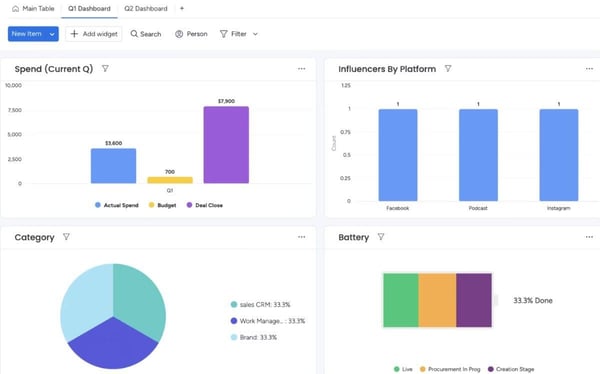
Source
This example is basically like an influencer tracking spreadsheet on steroids. It's more visual than a spreadsheet and makes sharing and reporting on campaigns easier with graphs and charts for your team, clients and key stakeholders.
While this method offers more in-depth tracking, it still requires you to keep everything up-to-date manually. Project management tools are ideal for brands that need a stopgap solution between a spreadsheet and dedicated influencer campaign management tools.
Influencer Content Management Tools
For brands aiming to maximize their schedules and keep a strong pulse on their influencer content, leveling up to a dedicated influencer management platform is a must-have.
These are influencer marketing platforms with dedicated features to help brands monitor influencer performance and gather content with minimal legwork.
For example, influencer tracking tools like Statusphere monitor every piece of your campaigns including approved content, influencer post engagement rates and the progress of your brand's campaign.
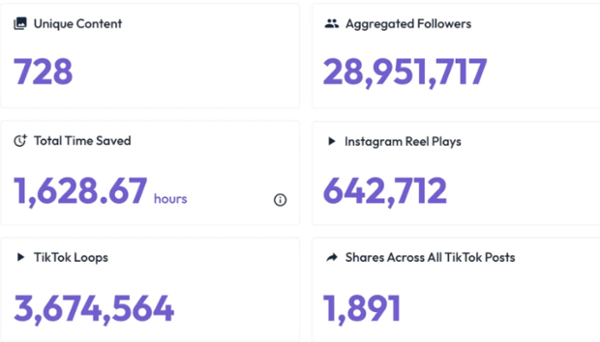
Spreadsheets and workarounds only go so far and won't save you significant time if you plan to scale your campaigns to 100s or 1000s of creators.
On the flip side, influencer management platforms are best for brands with an always-on influencer strategy that want to maximize campaign ROI and treat creator campaigns like a proper performance marketing channel.
4 Influencer Content Tracking Platforms for Brands to Try
Brands are spoiled for choice when it comes to marketing tools and influencer tracking platforms are no exception. Below is a breakdown of four to test-drive depending on the scope and size of your current creator campaigns.
Statusphere's solution is best for brands that want a completely automated way to manage influencers and track their performance. The platform handles everything from tracking influencer posts across TikTok and Instagram to managing UGC rights in real time.
Brands can instantly access engagement rates and other influencer metrics tracking while also seeing their campaigns' progress, including how many posts have been made.
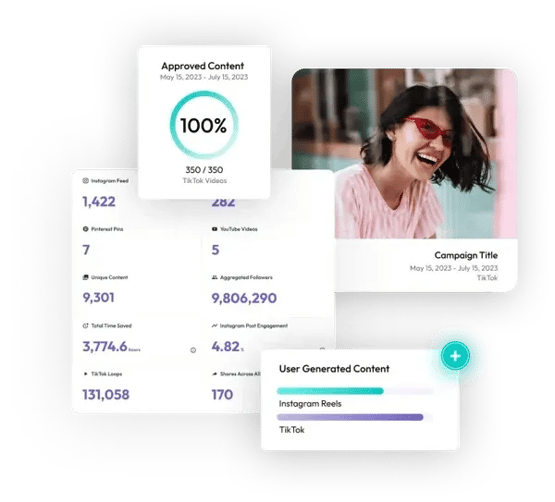
Another point that makes Statusphere different from other influencer platforms is the ability to track campaign content for hundreds of creators, including high-volume product seeding campaigns.
Brands can use the platform to send products to their own list of influencers or match with new creators. Guaranteed delivery and built-in shipment tracking for creators means brands don't have to spend time updating spreadsheets or managing one-on-one communication.
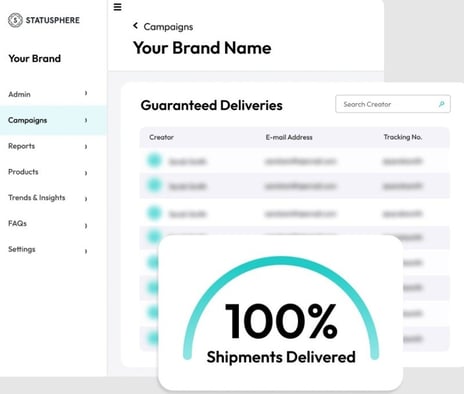
With all of the above, brands don't need to chase creators or check metrics manually. Since collabs within Statusphere are pre-negotiated, brands likewise don't need to worry about tracking creator compensation and payments.
Gatsby.ai's is designed for brands that want to uncover posts from creators who are already loyal customers. The platform's features balance influencer marketing with customer loyalty, helping brands track their organic UGC and new opportunities to engage creators.
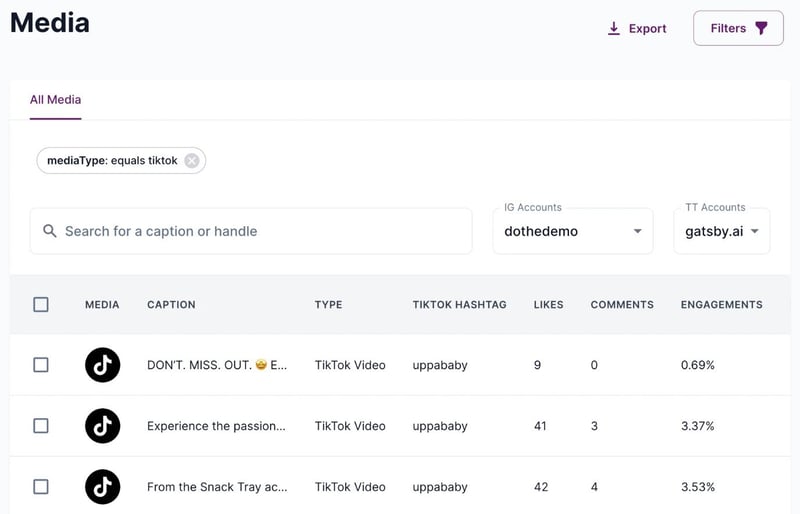
Built-in tools like social listening and automated replies make it easier for brands to engage with individual creators while also tracking their posts. For reference, the platform can track performance metrics including post engagement rates, total interactions and hashtag uses.
Traackr offers brands control over their influencer collabs and the ability to track content. The platform provides real-time performance data and ongoing analytics across multiple social media platforms, including the usage of branded keywords and hashtags.
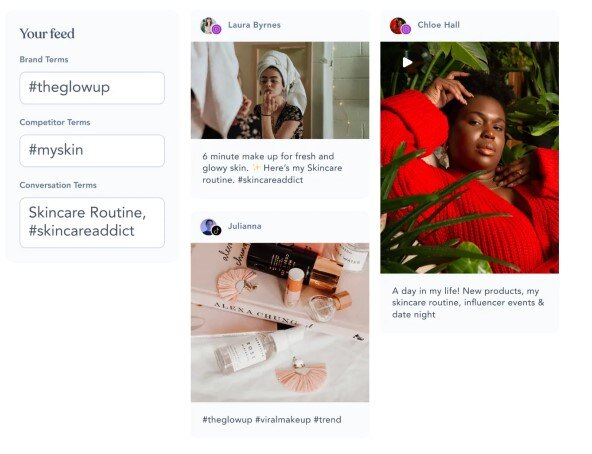
Beyond insights for existing posts and collabs, the platform also has built-in social listening for finding new creators. Traackr’s emphasis on discovery and precise campaign management is ideal for brands that want highly customized partnerships with a very hands-on strategy.
Modash's platform specializes in helping brands verify influencer authenticity and highlighting actions that influencer managers need to take to approve their creators' posts.
For example, a key feature of Modash is its alerts. The platform can provide a summary of your campaign and actions that still need to be taken by creators such as including a specific hashtag or adding in an ad disclosure that's missing.
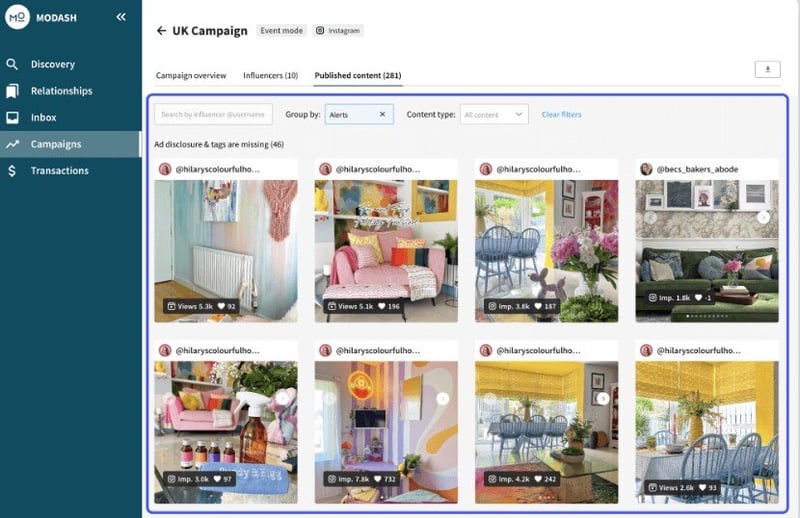
Modash’s platform is ideal for brands that want to keep tabs on their creator campaigns in one place, all while understanding what needs to be done to approve any given piece of content.
How to Start Tracking Influencer Content & Campaigns with Confidence
Your approach to content tracking is make-or-break. Especially as marketing teams focus more and more on campaign ROI and aligning creator campaigns with bigger business goals.
And if you want to take a results-driven approach to influencer marketing, you need tools built to track all of the moving pieces of your campaigns.
While spreadsheets and other tools can streamline your day-to-day influencer tracking tasks, Statusphere’s software goes a few steps further by eliminating those tasks altogether.
Our influencer marketing platform matches brands with vetted creators based on 250+ first-party data points and also allows you to upload your own creator lists. We give brands an all-in-one solution for tracking campaigns, content rights and shipments with no legwork on your part.
Want to see how our platform works? Get in touch with one of our experts to see why Statusphere is the best influencer tracking tool for brands that want to scale UGC.
